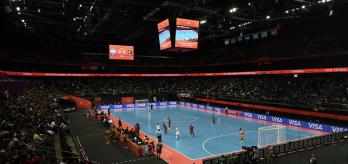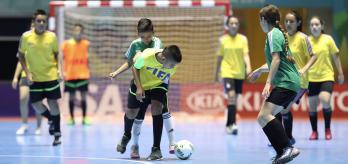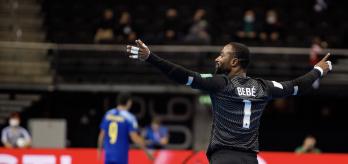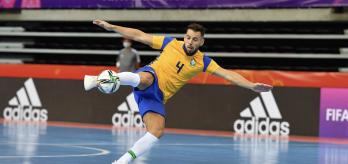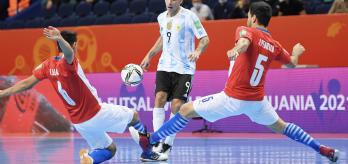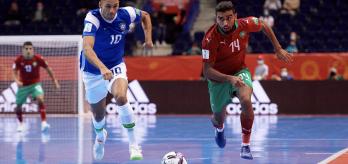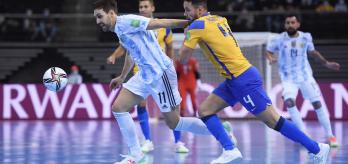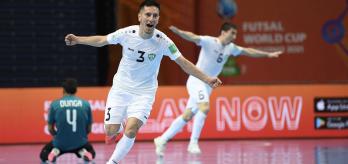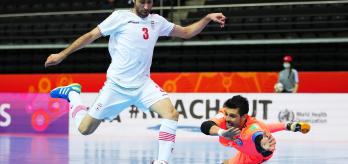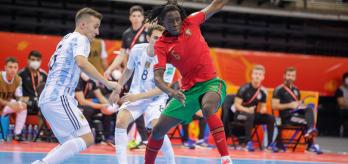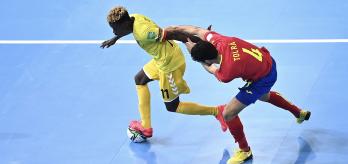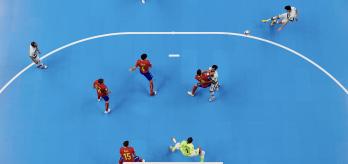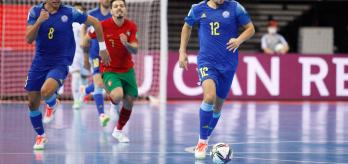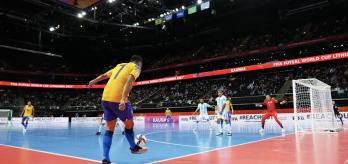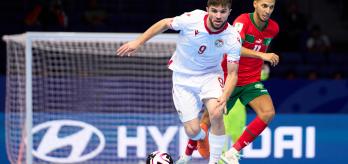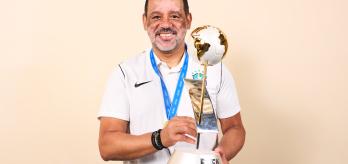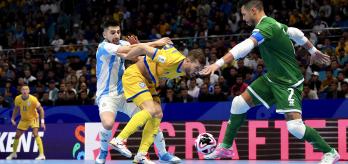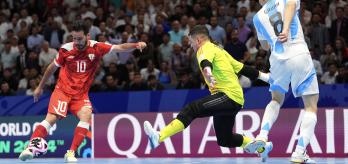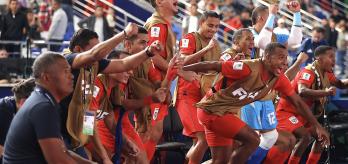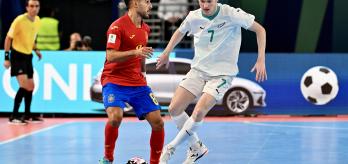Approach
Fluidity in attack linked to patience and positive passing were key outcomes from this analysis. Most, if not all, teams in the competition worked in quads – that is to say, three banks of four players without interchanges, albeit some used four players from two banks of six, with an understanding between them. While we would expect to see familiarity in playing patterns and consistency of movement, this was less evident among those teams eliminated at the group stage compared with those still involved from the round of 16 onwards.
For the TSG, the ability to move from rigid attacking formations and to show flexibility when encountering a variety of defensive blocks was crucial to success. Strict and rigid systems throughout an entire game are no longer common and, at elite level, we see a prevalence of switches between playing systems. Some of this is deliberate while some is coincidental but nevertheless has an impact.
Portugal demonstrated considerable fluidity in their play, largely down to the influence of Ricardinho who made 658 passes across their seven games in the competition, underlining the importance of strong accurate passing to successful teams. The player closest to that tally was Douglas of Kazakhstan with 643 while, intriguingly, his team-mate Higuita (KAZ) was the tournament’s third-highest passer, demonstrating the increasingly important role of the goalkeeper in outfield play. This fluidity was reflected in the systems of play: amid the ebb and flow of players, we saw systems of 1-3, 3-1, 2-2 and 4-0 all utilised within the same phases of play. For newcomers to futsal, as well as inexperienced futsal coaches or players, these systems of play may not at first be fully noticeable – certainly not to the untrained eye as teams at this level play with such speed of movement, of both players and ball. Yet even if the game appears full of totally random movements, the systems deployed remain evident.
Iran could be considered to have applied this approach in a similar vein, albeit at slower speeds and with more pauses in play. Kazakhstan, by contrast, were generally slower in their build-up play and more deliberate in their movement and passing, with Douglas the key orchestrator in every one of their matches. They were a team that played deliberately to the strengths of individual players and credit should go to coach Paulo Figueroa for recognising these key facets and exploiting them within their strategic approach. It was notable that 10 of their 13 goals came from Taynan (6) and Douglas (4) two of the oldest players. Was age a factor in their more patient approach?
Similarly, Argentina showed attacking prowess often from deep or mid-third positions, attacking spaces with fast and penetrative movement, specifically through Cristian Borruto and Constantino Vaporaki. Their most decisive attacking work came from individual movement and play, and it seems no coincidence that both Argentina and Portugal reached the final with such philosophies, showing the value of understanding between players and consistency of squad selection.
The TSG also noted an increase in 1v1 attacks which relied more on the technical ability of the player than orchestrated team movement and passing. There were reasons for this which were not necessarily consistent across all teams. Whether it was a successful strategy is a moot point, though it may have contributed towards better than expected final placings for some teams. Here, Morocco offered an example, with Youssef Jouad and Hamza Bouyouzan exemplifying a free attacking spirit.
Iran also tended to mount attacks with single players such as Ali Asghar Hassanzadeh and Farhad Fakhim, while from Argentina we saw Borruto and Angel Claudino demonstrate their individual qualities in attack. Portugal’s Pany offered another example of looking to the individual.
It is worth adding that the lack of a structured attacking plan can result in end-to-end games, with possession surrendered easily.
On the subject of possession, the data collected indicates that it was less critical to outcomes than had previously been considered. As an example, Panama had more pass completions than any other team at the end of the group phase but did not progress, demonstrating the importance of where you pass and how that links with attacking phases of play.
Thailand, meanwhile, were able to show good phases of play in possession for such a young team although, as demonstrated against Portugal, they were unable to convert sizeable chunks of possession into meaningful attacks. Herein lies a challenge for developing nations in that play must be directional and outcomes should reflect the effort applied.
Observations
The TSG identified this as a concern for ongoing futsal development. Teams cannot rely upon their most skilful player to create an attacking opportunity; rather they need to retain possession and use it to seek out passing lines and shooting opportunities, rather than see it easily surrendered. This requires developmental coaching.
Age
In Lithuania, with the increased average age of teams at this Futsal World Cup, there seemed to be a heavier reliance on experience rather than youth. For the TSG, a mix of the two is important and Portugal were seen as an example of a team with the courage to place confidence in the next generation and blend this with experience.
Physicality
Physicality was another factor worthy of discussion. Ivan Chishkala (RFU), Birzhan Orazov (KAZ), Pito (BRA), Taynan (KAZ) and Alan Brandi (ARG) were all players who had the physical presence to put pressure on their opponents. This was a useful asset when their teams were pressing high. The temperament of these players warrants a mention too as they were able to impose their physicality while playing with composure.
Less fouls
Another factor when considering attacking play is the significant reduction in the number of fouls conceded at this World Cup. This was evident when considering the fouls resulting in a direct free-kick from the 10m mark, a number which has fallen at each World Cup since 2000 with just nine in Lithuania compared with 50 in Guatemala in 2000. The TSG looked at this data in some detail and cited a number of possibilities to explain the ongoing reduction: greater periods of possession and more accurate and quicker passing resulting in fewer challenges could be a reason, as indeed could be the prevalence of direct attacks that reduce player contact. The group also asked if changes in refereeing approaches over successive World Cups could have impacted on these statistics.
Role of the pivot
The TSG looked closely, meanwhile, at what appeared to be the increased significance of the pivot, and focused its attention specifically on four players: Zicky (POR), Ferrao (BRA), Brandi (ARG) and Pito (BRA). These four, as the data shows, created by some distance the most pivot-play opportunities per 40 minutes. It is important to look beyond the obvious in match and player assessment and here we have to rely upon the data to support or challenge perceptions. Pivot play is a vital, historical, ingredient of futsal team play, but the action of playing into the pivot has to be effective. Vinicius Rocha (BRA) gave a masterclass in pivot play against Argentina with an impressive balance of speed and composure.
Looking at the effectiveness of those playing in the pivot role, Portugal’s Zicky appeared in this position on numerous occasions across their tournament games, receiving 55.4 successful forward passes per 40 minutes of game time with 15.5 pivot actions (that is, being in the pivot position and producing either a shot, a pass leading to a shot/goal or a take-on) per 40 minutes. These figures are almost double that of Ferrao’s for Brazil (31.9 per 40 minutes with 10.8 pivot actions) and demonstrate the effectiveness of Zicky as a pivot versus the more established Ferrao. Trailing behind these two were Brandi (24.3/3.5) and Pito (5.3/1.2) so we also have to consider the effectiveness of the use of the pivot and the value of players in that role. Certainly in the semi-final game, Zicky caused Argentina a variety of problems.
The pivot is not always going to receive the ball and create a shooting opportunity or a 1v1 take-on. The role also entails being a provider for others. It is a team game and the data from this World Cup shows that an overall ‘play-to-pivot’ strategy is required for the role to be fully effective.
Not every team appears to fully understand how to play against the pivot although Kazakhstan, in the 3rd place play-off against Brazil, offered a masterclass in how to successfully mark and frustrate the pivot as Ferrao soon became flustered and ineffective, with his team-mates suffering similarly in the pivot role.
On a separate note, teams also showed a tendency to play too fast in possession, lacking the technical capability to do so well. This was not just evident among the lower-placed teams but across all stages of the competition. Composure in play, specifically in the attacking phase, is vital so as not to surrender possession. The principle that an attacking phase must always end in a shot or a goal is misplaced. Instead we must recognise that the principles of the attacking phase are varied and can depend on factors such as the flow of play, the scoreline and the stage of the game.
Here we can cite Uzbekistan, Egypt and Solomon Islands as examples. Pace and energy has to be harnessed with technical and tactical balance.
Innovation
The TSG also recognised innovation in attacking play and this was specifically evident in the play of RFU, in particular when applying the 4-0 formation. This involved the occasional departure from the conventional pairs working in a butterfly movement on the wings to retain and recycle possession, with the forward-most player of the pair making a deliberate vertical retreat run to receive the ball with his back to goal in zone 2 and delivering a release pass to the opposite flank for a forward breakaway by one of the opposite pair (see clip below). It is a ploy to exploit space and has the element of surprise as a change from the anticipated movement by the team in possession.
Overall, it was evident in the group stage that attacking play was often punctuated by the loss of possession through basic, unforced errors. This may have a connection with the way some teams relied on playing to the strengths of individuals, rather than what was evidenced as the weaknesses of the collective five. It was also evident that a number of those teams exiting at the group stage suffered for only applying a basic game plan with no variation in playing style or tactics. Here the TSG specifically cited the approaches of the Solomon Islands, Guatemala and Panama, despite Panama being the team with the greatest number of pass completions at the end of the group stage. By contrast, those teams who competed in the knockout stage offered variation and flexibility in their play.
Style
Morocco were a team who surprised many, a team who grew into the competition with confidence and an evolving tactical plan. Their exemplary performance in the quarter-final defeat against Brazil underlined the emerging talent pool on the African continent and the clever coaching of Hicham Dguig warranted praise from the TSG. On the evidence of this World Cup they can be classed among those teams who are closing the gap on the top tier of futsal nations. Strongly organised in defence yet attacking with individuals such as Youssef Jouad and the ever-reliable Bilal Bakkali (one of the top six passers of the tournament), they suggested they could be a team to watch three years from now. Additionally, the confidence they place in youth augurs well for their efforts to build on this showing.
The trusted far post tap-in, synonymous with futsal for decades, is a less common route to goal now owing to the advances in technical play, counter-attacking and goalkeeping agility. Of course, goals are still scored in this way but not in the same volume as over the past two decades, which is a further indication that the game is changing. We see more 1v1 duels, more take-ons, direct play and more pivot actions. There is also an increased awareness by teams of their competence when out of possession, defending, and this led the TSG to conclude that whilst much trust is placed in individuals offensively, the opposite was true defensively.
Where a team does not build an attack or play through the mid-third, looking instead to individual attacking play, this may signify a change in tactical planning or it could be a reflection of a squad's limited technical capabilities. It may bring results but is not a long-term solution.
Philosophies
The data sheds light on teams’ attacking philosophies and the four semi-finalists produced the highest number of shots throughout the competition with Brazil leading the way with a huge 354 resulting in 26 goals scored (excluding own goals), followed by Portugal (340/24), Kazakhstan (335/21) and then Argentina (322/26). A significant gap then to RFU (288/21) and then Spain (230/19) with everyone else trailing further behind. It is no coincidence that these six teams were also the six teams with the greatest efficiency in shots to goals.
Another point of intrigue was the difference in the performance levels of the more technically gifted and tactically aware teams who seemed to find another level against opponents of a similar stature yet suffered difficulties against less orthodox, lower-profile teams. Here the TSG observed how Argentina, for instance, struggled in the first half against a Paraguay side who were technically competent and applied pressure in all areas and, crucially, played a longer game to stretch the play – something that Argentina struggled at first to adapt to. The second half was a different story as Argentina did adapt and turned the game around through a tactical change. Yet that contest should encourage aspiring nations that taking a game to an experienced opponent can have positive outcomes. This is about game-to-game approaches rather than a one-size-fits-all.
Playing systems
When it comes to playing systems, the high speed to-and-fro of today’s futsal means clear patterns can be hard to discern at times, and the TSG were not convinced that one system was necessarily more effective than another at this World Cup. The example of those teams now challenging below the established top tier of teams would suggest success was more down to application than a particular structure or system. That said, there is a strong conviction that tactical flexibility and fluidity are a vital component for a successful team.
Conclusion
In considering how teams structured their play, the TSG looked at how reliant they were on specific players to score goals – in other words, if they structured their tactics to get certain players into scoring positions. Of those teams that scored 10 or more goals, Brazil (28), Argentina (27), Portugal (26), Kazakhstan (24), Spain (19) and Serbia (14) demonstrated a greater reliance on certain players for goals whereas with other nations the goals were more spread around.
This arguably supports the perception that teams were reliant upon players with more variable skill-sets than previously seen. It was also seen as a reflection of the more direct play witnessed, as opposed to those goals sourced from build-up play where the positional approach of key players was more calculated.



